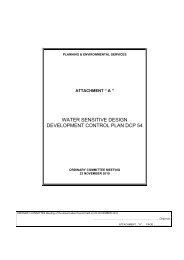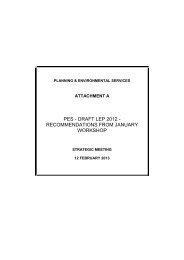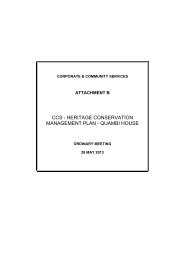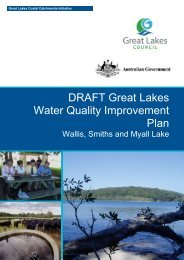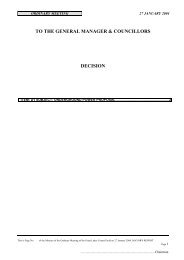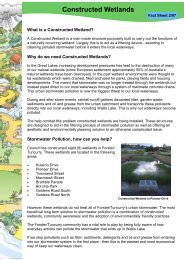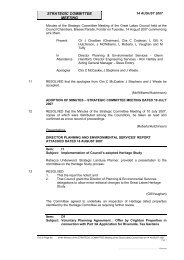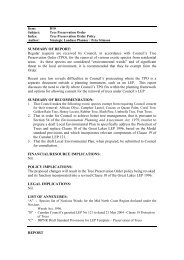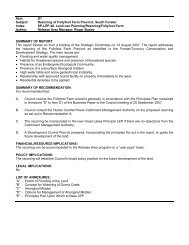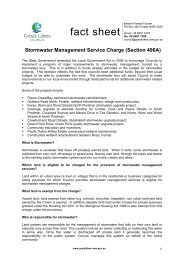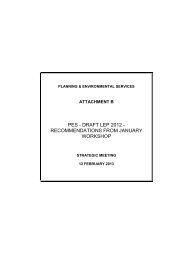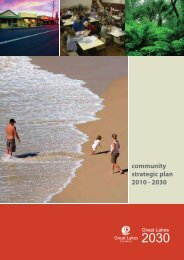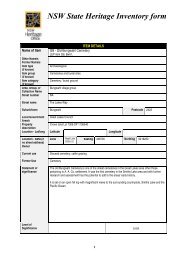13.2 The Wallis Lake Estuary Management Committee - Great Lakes ...
13.2 The Wallis Lake Estuary Management Committee - Great Lakes ...
13.2 The Wallis Lake Estuary Management Committee - Great Lakes ...
You also want an ePaper? Increase the reach of your titles
YUMPU automatically turns print PDFs into web optimized ePapers that Google loves.
<strong>Wallis</strong> <strong>Lake</strong> <strong>Estuary</strong> <strong>Management</strong> Plan<br />
11 Glossary<br />
Aesthetic:<br />
Acid Sulfate Soil:<br />
Aquaculture:<br />
Biodiversity:<br />
A theory as to what is beautiful or appealing. In this plan the aesthetic amenity of the<br />
estuary is a combination of scenic attributes and water quality.<br />
‘Soils containing materials that are rich in sulfides, primarily pyrite, which when oxidised<br />
produce acidity in excess of the sediments capacity to neutralise the acidity resulting in<br />
soils of pH 4 or less’ (LNCCMB, 2002).<br />
‘Farming of aquatic organisms including fish, molluscs, crustaceans and aquatic plants’<br />
(LNCCMB, 2002).<br />
‘<strong>The</strong> variety of life forms, the different plants, animals and microorganisms, the genes they<br />
contain and the ecosystems they form’ (LNCCMB, 2002).<br />
Catchment: ‘<strong>The</strong> area of land drained by a river and its tributaries’ (LNCCMB, 2002).<br />
Commercial:<br />
Cultural:<br />
Denitrification:<br />
Ecosystem:<br />
Pertaining to business related activity resulting in profit.<br />
In reference to values pertaining to the Aboriginal community including language, songs,<br />
art, customs, beliefs and environmental knowledge; and physical attributes such as<br />
artefacts, scar trees, carvings and burial and ceremonial places.<br />
<strong>The</strong> microbial reduction of nitrate to di-nitrogen gas.<br />
‘Communities of organisms and their physical environment interacting as a unit’ (LNCCMB,<br />
2002).<br />
Effluent: ‘Human and animal waste in a liquid form’ (LNCCMB, 2002).<br />
Environmental:<br />
<strong>Estuary</strong>:<br />
Eutrophication:<br />
Faecal coliforms:<br />
Relating to the natural world including the physical, chemical and biological components<br />
and the way in which they interact.<br />
‘<strong>The</strong> tidal portions of river mouths, bays and coastal lagoons, irrespective of whether they<br />
are dominated by hypersaline, marine or fresh water conditions’ (Hutchings & Collett<br />
1977). Included in this definition are inter-tidal wetlands, where water levels can vary in<br />
response to the tidal levels of the adjacent waterway, together with perched freshwater<br />
swamps, as well as coastal lagoons that are intermittently connected to the ocean.<br />
<strong>The</strong> collapse of a marine, estuarine or aquatic ecosystem due to excessive algal blooms,<br />
accumulation of nutrients in sediments, and low levels of dissolved oxygen.<br />
‘Bacteria which inhabits the intestines of humans and other animals, and are present in<br />
faeces. <strong>The</strong>ir presence in water quality testing indicates faecal contamination of water and<br />
that other more serious pathogens may also be present’ (LNCCMB, 2002).<br />
113




